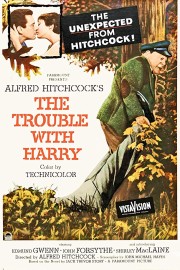The Trouble With Harry
Alfred Hitchcock had a penchant for dark comedy in his films. His humor was always capable of being jet black and light as a feather. This is my first time watching his film, “The Trouble With Harry,” and I did not expect it to be pure comedy. Yes, the genre is technically “mystery,” as well, but that’s more the Hitchcock reputation than the narrative being put forth in this delightful film. Nobody really cares how Harry died; it’s more of how much of an inconvenience his death will cause to the lives of the characters is what matters more. Stupid death, getting in the way.
I did not expect “The Trouble With Harry” to be the film it was; I’m so used to “Master of Suspense” Hitchcock that the setting and tone of this film threw me for a loop. With all great Hitchcock, and even pretty good Hitchcock, it’s not hard to fall into this film’s rhythms and just go along for the silly ride being laid out in John Michael Hayes’s script from Jack Trevor Story’s novel. The first half of the movie almost entirely feels set in a meadow clearing in the woods just outside a simple Vermont town. The body of Harry Worp (Philip Truex) is first discovered by Captain Albert Wiles (Edmund Gwenn), who is hunting rabbit in the woods; he worries that he has mistaken Harry for a rabbit, and is the one who killed him. As he watches on, other people come across the body- Sam Marlowe, a local artist (John Forsythe); Jennifer Rogers (Shirley MacLaine) and her young son, Arnie (Jerry Mathers); a Tramp (Barry Macollum), who takes his shoes; even the town doctor (Dwight Marfield). Nobody is alarmed, however; everyone just seems to go about their business, and Jennifer, in her words, implies a closer relationship to Harry, and she’s not even that upset. We then move into town, and two more main players come into focus- Mrs. Wiggs (Mildred Dunnock), a store owner who is trying to sell Sam’s artwork, and Miss Ivy Gravely (Mildred Natwick), whom is interested in the Captain, and has her own ideas on Harry. How everyone goes about the day, and the fate of Harry, makes up the film’s wonderful 99 minutes.
Hitchcock is in peak form as a storyteller- in a way, it feels as though he’s doing a riff on an Agatha Christie mystery with trying to figure out how Harry died (there are a couple of different possibilities put out there), but it feels as though that is a secondary concern for the characters, and it’s hard not to agree with them; we are much more concerned with the character dynamics as each of these characters find their way into the other character’s orbit. The thing that separates this from a Christie film, and makes it firmly a Hitchcock one, is that there’s a wicked lack of empathy towards Harry’s death that is constant throughout the film’s characters. The thing that makes this a great film, and one of Hitchcock’s best, is how charming the characters are in spite of their basic apathy towards the death of Harry. Harry is not seen alive at any point in the movie, and we are only given brief ideas as to who he was as an individual by Jennifer, the only character who knew him while he was alive. What we learn gives us the impression that a good man has died, but in death, he is the film’s MacGuffin, the thing in the story that drives the plot, rather than an active participant in it. A similar tactic was used by Hitch in “Rope,” but that was used as a way of highlighting evil rather than bringing out good. Yes, there is apathy towards his death by the characters in this film, but we see a basic humanity come through in all of them as they struggle with what to do with Harry’s body, and hope they do not find themselves in trouble when one member of the community seems to be putting things together. The film becomes an exercise in suspense by Hitchcock in the last 20 minutes, but we feel like things will work out, because the people involved in the story have all become a team in their efforts to do right by them, and are not bad people, in their own right.
“The Trouble With Harry” walks a very small tightrope to succeed, but Hitchcock was a great filmmaker capable to balancing on it like no one else. That this rural Vermont town is so beautifully shot by Robert Burkes, whose use of fall colors just pops in this film, not only makes us feel at home in the film, but also makes us hope to not see a little thing like Harry’s death upset the apple cart, as it were; that’s what Hitchcock is banking on, along with showing us that even in the most quaint of American settings, death can be treated as a blase occurrence by the nicest people (all perfectly played by this cast). Finally, there is Bernard Herrmann’s score, which has familiar motifs from his previous collaborations with Hitchcock, but utilizes them for more comedic effect than suspenseful intent; it may be one of my favorite scores of his, and this may be one of my favorite Hitchcock films.










